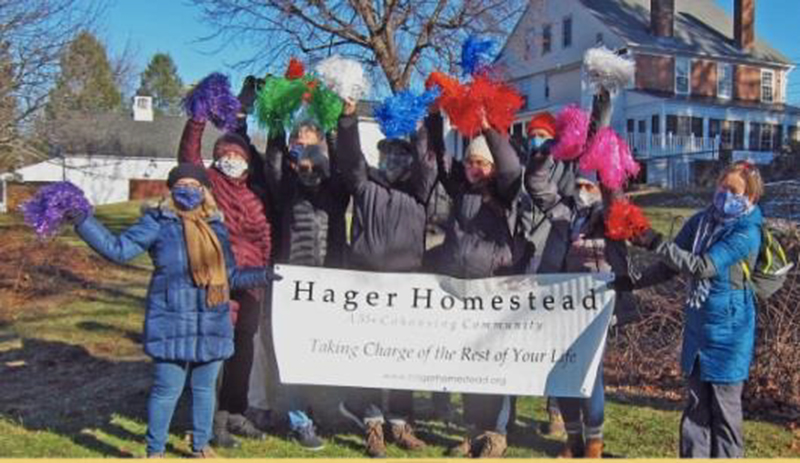
Littleton, MA Loneliness and social isolation in older adults puts them at risk for serious medical conditions. And the population of seniors in the U.S. is growing. By 2050, they’ll represent over 20% of the population–a “silver tsunami.” Is there a solution? Social engagement can significantly reduce rates of loneliness in older adults. Victoria Thatcher agrees. Thatcher, a retired editor and consultant, and husband Mayhew Seavey, an electrical engineer, are co-founders of Hager Homestead, a pioneering cohousing community to be built in town, 30 miles northwest of Boston. Thatcher got the idea when she lived in Denmark where cohousing began. In January, Hager won approval from the town’s planning board to construct the first cohousing community for 55+ adults in New England.
“Everyone ages,” Thatcher said, “but planning ahead – finding the ideal way to successfully age in place – is hard because you never know how your needs might change. We’re designing an old-fashioned neighborhood where members will be the architects of their own future, where each member has a sense of belonging and finds mutual support.” Cohousing consists of privately-owned homes clustered around shared green space and a common house with extensive shared amenities. Community members have as much privacy as they want in their homes and can find community by opening their front door. The financial structure is like a condo association.
Hager’s 15-acre King St. site, a former dairy farm, is a short walk from the center of town, town hall, and public library, and not far from the commuter rail station. The property abuts walking and bike trails.
Thatcher said, “Senior cohousing is a self-governed ‘intentional community’ that promotes a proactive, meaningful, mindful life.”
Hager’s 4,000 s/f common house (built in 1795) will be the social center with a large dining room and kitchen, living room, library, and other amenities.
While each home will have a full kitchen, members may choose optional group meals in the common house. Common areas and walkways are designed so members will meet informally.
Planning for Hager started in 2018 and early member Diane Loomis notes the group has a 1,200-name database.
With just 24 housing units and 12 already pre-sold, there will be strong competition for remaining units. She says, “Our success isn’t surprising. With the growing housing crisis, we’re offering a purposely designed community where everyone has a say, where you can be as involved as you wish, and where there is lots of opportunity for connecting with each other.” Decisions will derive from ‘work circles,’ each with its own area of focus.
While there are about 170 cohousing communities across the U. S., Kathryn McCamant, president of Cohousing Solutions, and consultant to Hager, said, “Cohousing is not just adjacent buildings, it’s members working together, building consensus. It’s inclusive, collaborative, deliberate–where all members are involved, seeking the best solutions with shared vision, less conflict, and more support. She refers to it as a ‘sociocracy.’ The bottom line: Nobody wants to age alone – and here you won’t.”
Thatcher said, “With cohousing, you can be alone when you want. You can join in community activities when you want.” Experts agree that the most important factor in aging successfully in place is proximate neighbors who know and care about each other. It’s exactly what cohousing provides: It’s not about the house, it’s about the community. “We’re not really selling houses, we’re selling community. I tell people, we’re selling community, and we’ll throw in a nice, small, energy-efficient house to boot. Many Baby Boomers want a downsized, community-oriented, environmentally-friendly lifestyle.”
Matthew Blackham, a noted multi-housing and commercial property developer, has worked with Hager on site selection, permitting, design, and soon, construction. He said, “This is one of my more enjoyable projects, working with a group to develop their dream community. As a real estate developer, we traditionally refer to a project as a ’24-unit community.’ In reality, once projects are completed, there’s not much of a ‘community.’ People pass each other and say hello, but rarely get together. In cohousing, the project is socially engineered and programmed. Community involvement and interaction is why people like this option. As the pandemic has socially isolated so many, I have seen this cohousing group form a community even without a completed project.”
Barbara Melnick, a retiree in her 60s, has reserved a unit. “Littleton has fabulous lakes, hiking trails and wildlife. I was drawn to the community aspect of the cohousing. I look forward to cooking and eating with the group and to gardening with neighbors. I know that joining a cohousing community will involve working together to get things built now and keep things running smoothly once we move in. I welcome this new activity and focus to my life.”
Another member of the planning group is Susan Cournoyer, a former high tech market analyst and human services counselor. She likes the cohousing concept as “a way to build community, by building relationships with neighbors... It’s important to me that it allows people to contribute the skills that they have, and to benefit from the skills that others can contribute.”
 (1).png)







